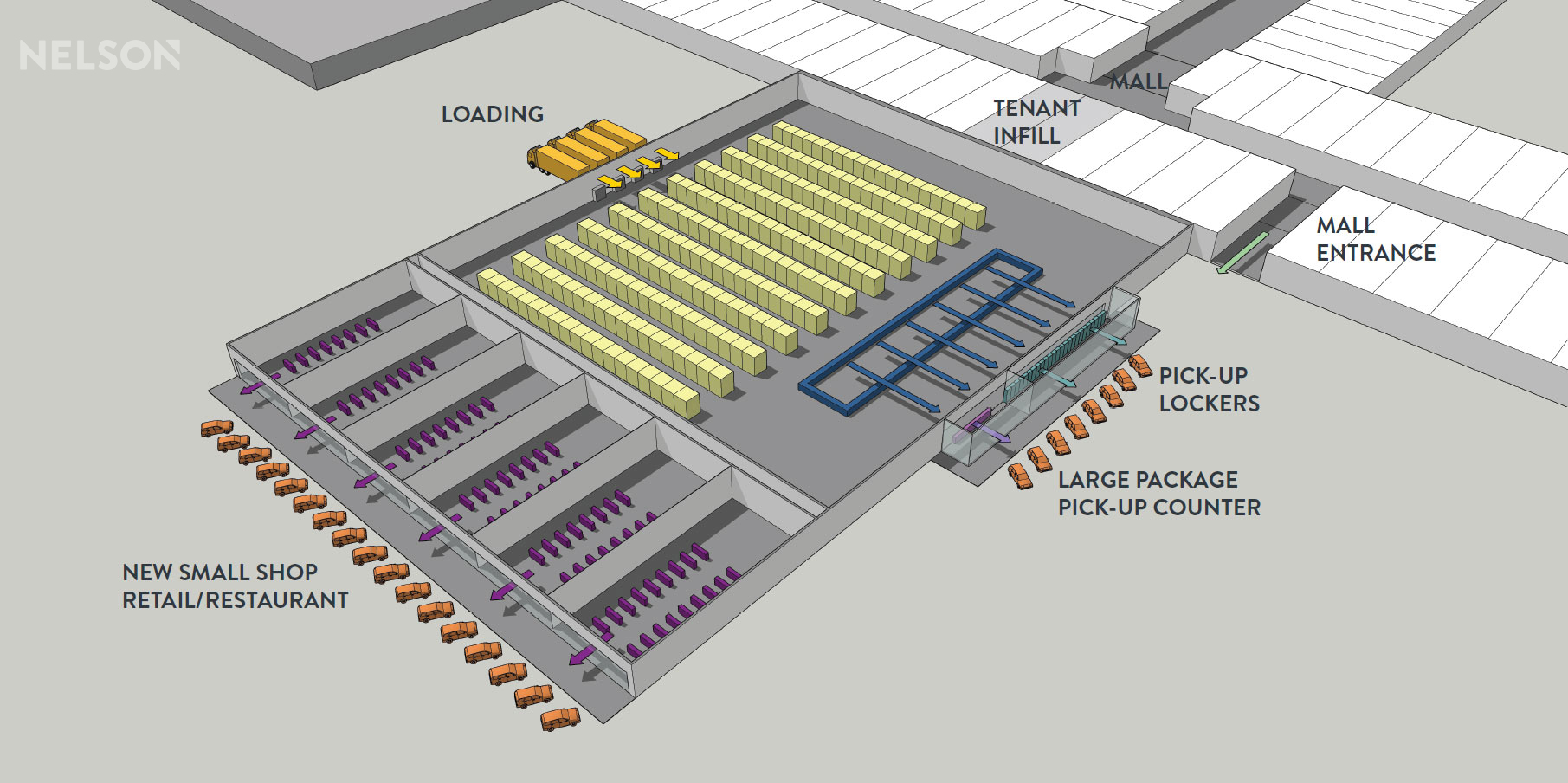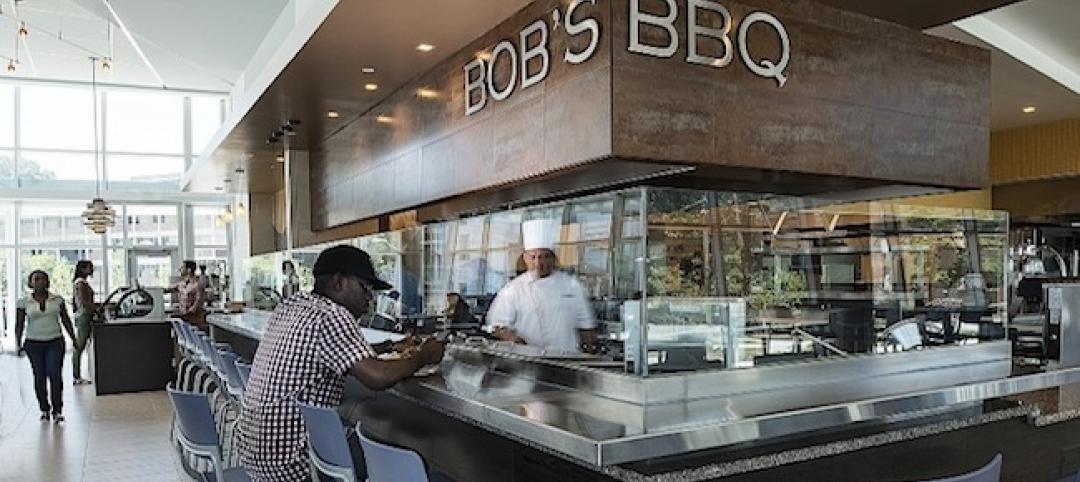Last month, one of the world's most well-known retailers filed for bankruptcy. Barneys is almost 100 years old and will close 15 of its 22 stores as part of a major restructure, and they aren’t alone. Barneys is among dozens of other retailers filing for bankruptcy this year. The question is, how do landlords transform this valuable empty space? The solution lies in repurposing existing square footage.
Brick-and-mortar environments can no longer offer consumers a singular purpose. Developments must be multi-functional destinations, hybrid facilities that support retail’s changing landscape and benefit the consumer, retailer, and the developer. The goal is to create physical environments that offer both a differentiated customer experience but also one that allows for faster product access.
With a national vacancy rate over 10% and a market that’s inundated with empty anchor space, the challenge will be to repurpose these once thriving mall beacons to become multi-purpose destinations that are both functional and still aesthetically pleasing for developers and remaining anchor tenants. The solution for dark anchors should not be to simply "plug the hole" with traditional solutions, but to look toward "out-of-the-box" concepts. A more innovative distribution center concept can offer a longer-lasting, versatile solution focusing on engagement, helping with supply chain, and better addressing today’s speed of transaction. The ideal repurposed distribution center offers three distinct uses.
First, is a warehouse “lite” facility offering last-mile delivery services – a smaller format transportation hub focusing on last-mile logistics to deliver items to the end user as fast as possible. The repurposed distribution center could leverage key elements from previous anchors, like the loading dock, receiving area and freight elevators. And keeping truck traffic to the backside of the development, ideally with a separate entrance, prevents a disruption to guest traffic flow.
Next, a robust click-and-collect facility, from parcel lockers to drive-through pick-ups, it will allow customers, as well as third-party delivery vendors, faster access to merchandise. This could also support newer concepts like cloud kitchens that rely on multiple delivery providers and a seamless pick-up process. Supporting new business-models from BOPIS to ridesharing, will keep the concept fresh and flexible, to support the growing ecommerce market.
 One solution for dark anchors is to convert them to warehouse “lite” facilities, which offer last-mile delivery services. The repurposed distribution center could leverage key elements from previous anchors, like the loading dock, receiving area and freight elevators. Rendering: NELSON
One solution for dark anchors is to convert them to warehouse “lite” facilities, which offer last-mile delivery services. The repurposed distribution center could leverage key elements from previous anchors, like the loading dock, receiving area and freight elevators. Rendering: NELSON
The third and final usage will be to leverage the street-facing facade for new, small format retail and restaurants. Providing unique localized offerings and a varied tenant mix will keep the development feeling current. These new consumer-facing environments should offer plenty of opportunities for consumer engagement and provide a new draw for legacy tenants within the development.
The refreshed exterior will help increase street traffic while creating an aesthetically pleasing façade to the much-needed back-of-house functions within the warehouse and click-and-collect environments. The small-format footprint could entice new offerings from start-ups to online-first retailers, providing developers and guests an elevated and differentiated experience.
This multi-faceted concept could support various industries beyond just traditional retail, such as breweries, beer distributers, and a consumer-facing beer garden or tasting room. With the rise of farm-to-table dining, it could be home to a grow house, farmers market, and signature-chef restaurant. Or even provide a footprint for cloud kitchens, a food truck park, and designated pick-up for food delivery apps. The options are endless when the concept supports consumers, ecommerce and supply chain.
Related content: In the age of Amazon there's nowhere to go but up
Moreover, many of today’s anchor spaces are large, unarticulated boxes that do not address today’s consumer needs and wants. The architecture is often forgettable and many of the exteriors haven’t been renovated since the original tenant opened their doors. This strategy may have been appropriate when most shopping centers were inward facing, enclosed malls, but today’s shoppers are looking for differentiated environments that not only speak to their unique communities, but also support their online habits to offer a more seamless, convenient experience.
So, while shopping centers have been turning inside out, replacing long stretches of back of house exterior walls with engaging outward facing tenant facades, the market has now created an opportunity for anchors to participate in this transformation.
This revolution starts with converting these unarticulated boxes into vibrant offerings that are approachable and engaging. Implementing a hybrid anchor solution provides a win for consumers, retailers, and developers, and will keep the space flexible for innovative new business models and functional for last-mile delivery opportunities. A new concept that merges experience with instant gratification to bring malls into the 21st century.
About the Author
Eric Arter leads the Mixed-Use studio at NELSON where he oversees a multi-disciplinary team serving both domestic and international clients including Simon, Brookfield, Unibail-Rodamco-Westfield, Macerich, Washington Prime Group, Cordish, Lotte and Hyundai Development Company. Eric has over 20 years of experience in mixed-use, retail, office, multifamily, hospitality, restaurant and entertainment projects as well as a background in institutional and industrial projects. Eric’s comprehensive experience and well-rounded skill set provides a unique understanding in support of a collaborative project approach. Projects in which he has played a key role have been the recipient of many awards throughout his career including: AIA Design & Honor Awards, NAIOP Awards and design competitions. Eric earned his Bachelor of Architecture degree from the University of Cincinnati. He is a registered architect, a member of the AIA, ICSC and he is a LEED accredited professional.
Related Stories
| May 29, 2014
7 cost-effective ways to make U.S. infrastructure more resilient
Moving critical elements to higher ground and designing for longer lifespans are just some of the ways cities and governments can make infrastructure more resilient to natural disasters and climate change, writes Richard Cavallaro, President of Skanska USA Civil.
| May 29, 2014
Retail renovation trends: Omni-channel shopping, personalized experiences among top goals of new store designs
In pursuit of enhanced customer experiences, retailers are using Big Data, interactive technology, and omni-channel shopping to transform their bricks and mortar locations.
| May 23, 2014
Top interior design trends: Gensler, HOK, FXFOWLE, Mancini Duffy weigh in
Tech-friendly furniture, “live walls,” sit-stand desks, and circadian lighting are among the emerging trends identified by leading interior designers.
| May 20, 2014
Kinetic Architecture: New book explores innovations in active façades
The book, co-authored by Arup's Russell Fortmeyer, illustrates the various ways architects, consultants, and engineers approach energy and comfort by manipulating air, water, and light through the layers of passive and active building envelope systems.
| May 19, 2014
Why e-commerce won't kill 'bricks and mortar' retail sector
Despite emerging structural challenges and newly-announced store closings, such as those of Radio Shack and Office Depot, the U.S. retail sector has continued on its solid recovery.
| May 13, 2014
19 industry groups team to promote resilient planning and building materials
The industry associations, with more than 700,000 members generating almost $1 trillion in GDP, have issued a joint statement on resilience, pushing design and building solutions for disaster mitigation.
| May 11, 2014
Final call for entries: 2014 Giants 300 survey
BD+C's 2014 Giants 300 survey forms are due Wednesday, May 21. Survey results will be published in our July 2014 issue. The annual Giants 300 Report ranks the top AEC firms in commercial construction, by revenue.
| May 6, 2014
'Ugliest building in New Jersey' finally getting facelift
After a decade of false starts and mishaps, the American Dream mall in the Meadowlands may finally get built.
| May 5, 2014
8 modern trends in student dining
Creating a dining experience for the modern millennial requires not only a deep knowledge of good design, but also an understanding of what makes today’s students tick. Culinary designers and consultants provide insights into what trends are transforming the campus table.
| Apr 30, 2014
Visiting Beijing's massive Chaoyang Park Plaza will be like 'moving through a urban forest'
Construction work has begun on the 120,000-sm mixed-use development, which was envisioned by MAD architects as a modern, urban forest.















